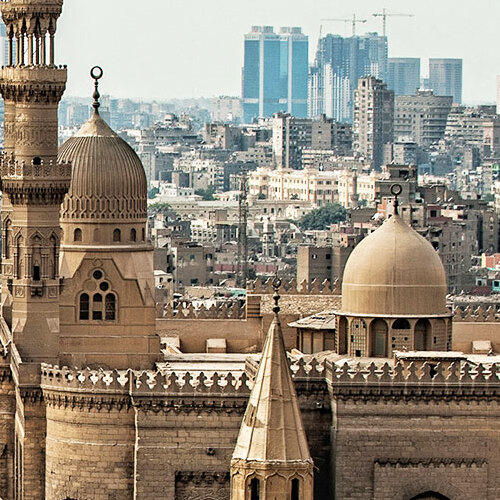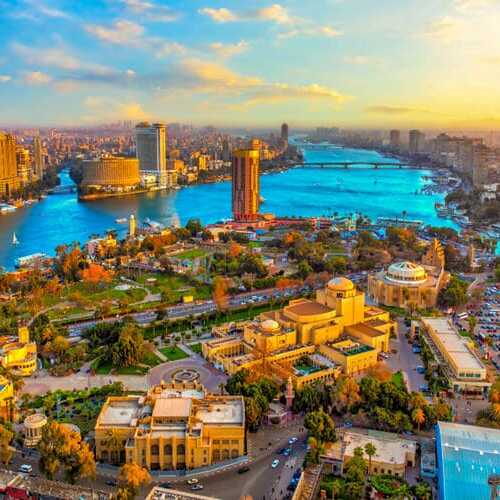No other nation in the world says ‘Welcome’ as often as the Egyptians, and every time, they mean it. While the ancient civilization of Egypt continues to amaze, contemporary Egyptians are equally remarkable.
Mosque of Ibn Tulun
The Mosque of Ibn Tulun: A Timeless Monument in Cairo
The Mosque of Ibn Tulun, standing as the oldest mosque in Cairo still intact and in continuous use, is a marvel of Islamic architecture. Its distinct and well-ordered indentations etched along the high walls make it an easily recognizable landmark in the city’s historic landscape. Built in the 9th century, the mosque was commissioned by Ibn Tulun, an Abbasid Caliph‘s representative from Baghdad, tasked with governing the Al-Fustat garrison.
Despite the constraints of a modest budget and a subsequent reconstruction, the Mosque of Ibn Tulun remains a jewel among Cairo’s religious sites. Its architectural design bears the hallmark of Ibn Tulun’s native Iraqi style, most notably influenced by the Mosque of Samarra. The mosque’s spiral minaret, a striking feature, is modeled after its Samarra counterpart. Innovatively, the mosque’s design includes pointed arches, a precursor to Europe’s Gothic arch by approximately two centuries.
Built on a grand scale to accommodate the entire community for Jum’ah (Friday) prayers, the mosque covers an expanse of over 6 acres. For the intrepid visitor, a climb to the top of the spiral minaret offers a breathtaking view of the Citadel. The mosque also features a tower situated outside a moat-like courtyard, symbolically separating the sacred space from the secular life of the city.
For those interested in delving deeper into the history and legacy of Ahmed Ibn Tulun, the visionary behind this architectural masterpiece, further information is readily available. The Mosque of Ibn Tulun is not just a place of worship but a testament to the rich tapestry of Cairo’s historical and cultural heritage.
Created On March 18, 2020
Updated On July 22 , 2025
CAIRO Travel Guide
- Al-Azhar Mosque
- Al-Azhar To The Citadel
- Amir Taz Palace
- Aqsunur’s Mosque
- Bab Zuweila
- Beit Al-Harrawi
- Beit Al-Suhaymi (Al-Suhaymi House)
- Beit Zeinab al-Khatoun
- Bein al-Qasreen STREET (Between The Two Palaces {Street})
- Ben Ezra Synagogue
- Church of St. Barbara
- Coptic Cairo
- Egyptian Textile Museum
- Gawhara Terrace
- Gayer-Anderson Museum
- Ibn Tulun Citadel
- Khan Al-Khalili Bazaar (Cairo’s Most Famous Bazaar)
- Khanqah & Mausoleum of Sultan Baybars al-Gashankir
- Khanqah-Mausoleum of Farag Ibn Barquq
- Madrassa & Mausoleum of as-Salih Ayyub
- Madrassa & Mausoleum of Qalawun
- An-Nasir Mohammed Bin Qalawoon Mosque
- Madrassa And Mausoleum of Barquq
- Mausoleum of Al-Ghouri
- Midan Al-Hussein (Sayedna Al-Hussein Square)
- Mosque of Al-Hakim
- Mosque of Al-Mu’ayyad Shaykh
- Mosque of al-Aqmar
- Mosque of Amr ibn al-As
- Mosque of An-Nasir Mohammed
- Mosque of Aslam al-Silahdar
- Mosque of Ibn Tulun
- Mosque of Mohammed Ali
- Mosque of Sayyidna al-Hussein
- Mosque-Madrassa of Al-Ghouri
- Mosque-Madrassa of Sultan Hassan
- Mosque-Madrassa of Umm Sultan Sha’aban
- Museo Mevlevi
- Museum of Islamic Art
- Northern Cemetery
- Northern Enclosure
- Northern Walls and Gates
- Sabil And Kuttab Of Abdel Rahman Katkhuda
- Sabil of Muhammed Ali Pasha
- Sharia al-Muizz li-Din Allah
- The Church of St Sergius & Bacchus
- The Citadel Of Saladin
- The Complex of Sultan Ashraf Barsbey
- The Coptic Museum (The Only Coptic Museum In Egypt)
- The Egyptian Museum
- The Hanging Church
- The Khayrbek Complex
- The Mosque of Sultan Qaitbey
- The Roman Towers
- Wikala al-Bazara
- Wikala of Al-Ghouri



